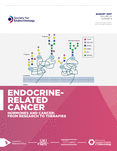Defects in homologous recombination repair behind the human diseases: FA and HBOC
-
Figure 1
An overview of the ICL repair pathway. When a replisome collides with an ICL (I), the leading strand initially stalls −20 nucleotides away from the lesion (II). After a second fork converges at the ICL, BRCA1 facilitates the dissociation of the CMG complex (consisting of Cdc45, MCM2-7 and GINS) from chromatin at the stalled fork, allowing the leading strand to approach to the −1 nucleotide adjacent to the ICL (III). In the next step, the SLX4-XPF-ERCC1 complex incises the DNA and unhooks the lesion in a FA pathway-dependent manner (IV). Translesion synthesis (TLS) polymerase (Polζ, or possibly Polκ, Polη, or Polι) extends the leading strand synthesis past the unhooked, ICL-associated nucleotide (V), and HR and the nucleotide excision repair (NER) pathway repair the remaining lesion (VI).
-
Figure 2
Schematic of HR pathway. When a double-strand break (DSB) is generated after DNA replication during S and G2 phase, both strands are resected in the 5′ to 3′ direction to generate 3′ overhangs. Almost immediately, replication protein A (RPA) is loaded onto the single-stranded (ss) DNA, and then replaced by a RAD51 nucleoprotein filament in a process requiring BRCA1–PALB2–BRCA2. RAD51 carries out strand invasion of the sister chromatid by the ssDNA tail and extends the resulting D-loop formation. In synthesis-dependent strand annealing (SDSA), the D-loop structure quickly dissociates from the ssDNA after synthesis of a complementary single strand, and then another strand anneals with a processed ssDNA. An alternate pathway forms a double Holliday junction (dHJ). After second end capture and fill-in synthesis, the Holliday junction is dissociated by the TopIIIα–BLM complex or resolved by resolvase complexes that contain SLX4, MUS81 and GEN1.
-
Figure 3
The mechanism of FA pathway activation. Upon replication fork stalling, FANCM–FAAP24–MHF1/2 complex binding at the ICL lesion activates ATR signaling, followed by the recruitment of the FA core complex. FANCI is phosphorylated by ATR, and subsequently, the FA core complex with UBE2T mediates the monoubiquitination of the FANCI–FANCD2 (D2-I) complex. This modification targets the D2-I complex to chromatin and leads to multiple events that repair the ICL lesion.
-
Figure 4
The primary structures of human BRCA1 and BRCA2. BRCA1 consists of 1863 amino acids. The RING domain is in the N-terminus and partly overlaps with the BARD1-binding region. BRCA1 interacts with PALB2 via a coiled-coil region in the C-terminus. The BRCT motif is a phosphorylated protein-binding sequence, and this motif mediates the association of BRCA1 with Abraxas, CtIP and BACH1, which are all known factors in DSB repair. BRCA2 comprises 3418 amino acids. The PALB2 binding region is located in the amino (N) terminus. In the center, BRCA2 harbors eight BRC repeats, which constitute a binding region for RAD51 monomers. In the carboxy (C) terminus, a DNA-binding domain contains three OB folds and a region that interacts with DSS1. The C-terminal region of BRCA2 is also important for the formation of the RAD51 nucleoprotein filament and BRCA2 nuclear localization.
- © 2016 Society for Endocrinology












